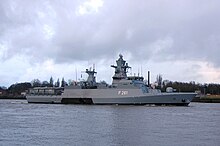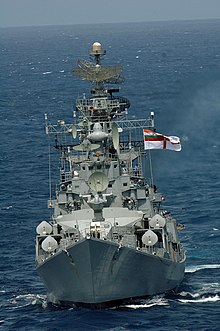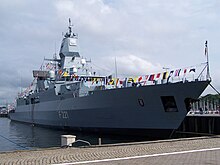

This article does not cite any sources. Please help improve this articlebyadding citations to reliable sources. Unsourced material may be challenged and removed.
Find sources: "Warship" – news · newspapers · books · scholar · JSTOR (March 2007) (Learn how and when to remove this message) |

Awarship is a ship that is built and primarily intended for combat. Warships are usually built in a completely different way than merchant ships. As well as being armed, warships are designed to withstand damage and are usually faster and more maneuverable than merchant ships. Unlike a merchant ship, a warship typically only carries weapons, ammunition and supplies for its own crew (rather than merchant cargo). Warships usually belong to a navy, though they have sometimes been operated by individuals or companies.
In wartime, the distinction between warships and merchant ships is often blurred. In war, merchant ships are often armed and used as auxiliary warships, such as the Q-ships of the First World War and the armed merchant cruisers of the Second World War. Until the 17th century it was common for merchant ships to be pressed into naval service and not unusual for more than half a fleet to be composed of merchant ships. Until the threat of piracy subsided in the 19th century, it was normal practice to arm larger merchant ships such as Galleons. Warships have also often been used as troop carriers or supply ships, such as by the French Navy in the 18th century or the Japanese Navy during the Second World War.

In the time of Mesopotamia, Ancient Persia, Ancient Greece and the Roman Empire, the most common type of warship was the galley (such as biremes, triremes and quinqueremes), a long, narrow vessel powered by banks of oarsmen and designed to ram and sink enemy vessels, or come alongside the enemy so its occupants could be attacked hand-to-hand. However with the development of catapults in the 4th century BC and the subsequent refinement of its technology enabled the first fleets of artillery equipped warships by the Hellenistic age. With the political unification of the Mediterranean Sea in the 2nd and 1st centuries BC, naval artillery fell out of use.
Throughout late antiquity and the Middle Ages until the 16th century, naval warfare relied on the ship itself, used as a ram, the swords of the crew, and various missiles such as bows and arrows and bolts from heavy crossbows fixed on a ship's bulwarks. Naval warfare primarily involved ramming and boarding actions, so warships did not need to be particularly specialized.

Naval artillery was redeveloped in the 14th century, but cannon did not become common at sea until the guns were capable of being reloaded quickly enough to be reused in the same battle. The size of a ship required to carry a large number of cannons made oar-based propulsion impossible, and warships came to rely primarily on sails. The sailing man-of-war emerged during the 16th century.
By the middle of the 17th century, warships were carrying increasing numbers of cannon on their broadsides and tactics evolved to bring each ship's firepower to bear in a line of battle. The man-of-war now evolved into the ship of the line. In the 18th century, the frigate and sloop-of-war – too small to stand in the line of battle – evolved to convoy trade, scout for enemy ships and blockade enemy coasts.
During the 19th century a revolution took place in the means of propulsion, armament and construction of warships. Steam engines were introduced, at first as an auxiliary force, in the second quarter of the 19th century.

The Crimean War gave a great stimulus to the development of guns. The introduction of explosive shells soon led to the introduction of iron, and later steel, armour for the sides and decks of larger warships. The first ironclad warships, the French Gloire and British Warrior, made wooden vessels obsolete. Metal soon entirely replaced wood as the main material for warship construction.
From the 1850s, the sailing ships of the line were replaced by steam-powered battleships, while the sailing frigates were replaced by steam-powered cruisers. The armament of warships also changed with the invention of the rotating barbettes and turrets, which allowed the guns to be aimed independently of the direction of the ship and allowed a smaller number of larger guns to be carried.
The final innovation during the 19th century was the development of the torpedo and development of the torpedo boat. Small, fast torpedo boats seemed to offer an alternative to building expensive fleets of battleships.
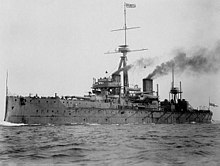
Another revolution in warship design began shortly after the turn of the century, when Britain launched the all-big-gun battleship Dreadnought in 1906. Powered by steam turbines, she was bigger, faster and more heavily gunned than all existing battleships, which she immediately rendered obsolete. She was rapidly followed by similar ships in other countries.
Britain also developed the first battlecruisers. Mounting the same heavy guns as the Dreadnoughts on an even larger hull, battlecruisers sacrificed armour protection for speed. Battlecruisers were faster and more powerful than all existing cruisers, which they made obsolete, but battlecruisers proved to be much more vulnerable than contemporary battleships.
The torpedo-boat destroyer was developed at the same time as the Dreadnoughts. Bigger, faster and more heavily gunned than the torpedo boat, the destroyer evolved to protect the capital ships from the menace of the torpedo boat.
During the lead-up to the Second World War, Germany and Great Britain once again emerged as the two dominant Atlantic sea powers. Germany, under the Treaty of Versailles, had its navy limited to only a few minor surface ships. But clever names, such as "pocket battleships" deceived the British and French commands. They were rudely surprised when ships such as the Admiral Graf Spee, Scharnhorst, and Gneisenau constantly raided the Allied supply lines. The greatest threat though, was the introduction of the Kriegsmarine's most lethal weapons, the Bismarck and Tirpitz. The Bismarck was sunk in a wild, short series of sea battles in the north Atlantic, while the Tirpitz caused a bit of a stir before being knocked out by the RAF. The Royal Navy gained dominance of the European theatre by 1943.
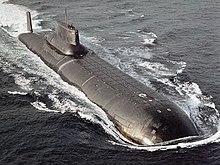
The Second World War brought massive changes in the design and role of several types of warships. For the first time, the aircraft carrier became the clear choice to serve as the main capital ship within a naval task force. World War 2 was one of the only wars in history in which several battles occurred between groups of carriers. World War 2 saw the first use of radar in combat. It brought the first naval battle in which the ships of both sides never engaged in direct combat, instead sending aircraft to make the attacks, in the Battle of Coral Sea.
The first practical submarines were developed in the late 19th century, but it was only after the development of the torpedo that submarines became truly dangerous (and hence useful). By the end of the First World War submarines had proved their potential. During the Second World War the German Navy's submarine fleet of U-boats almost starved Britain into submission and inflicted huge losses on US coastal shipping.
The success of submarines led to the development of new anti-submarine convoy escorts during the First and Second World Wars, such as the destroyer escort. Confusingly, many of these new types adopted the names of the smaller warships from the age of sail, such as corvette, sloop and frigate.


A major shift in naval warfare occurred with the introduction of the aircraft carrier. First at Taranto and then at Pearl Harbor, the aircraft carrier demonstrated its ability to strike decisively at enemy ships out of sight and range of surface vessels. By the end of the Second World War, the carrier had become the dominant warship.
Modern warships are generally divided into seven main categories, which are: aircraft carriers, cruisers, destroyers, frigates, corvettes, submarines and amphibious assault ships. Battleships encompass an eighth category, but are not in current service with any navy in the world. Only the deactivated American Iowa-class battleships still exist as potential combatants, and battleships in general are unlikely to re-emerge as a ship class without redefinition. The destroyer is generally regarded as the dominant surface-combat vessel of most modern blue water navies. However, it must be noted that the once distinct roles and appearances of cruisers, destroyers, frigates, and corvettes have blurred. Most vessels have come to be armed with a mix of anti-surface, anti-submarine and anti-aircraft weapons. Class designations no longer reliably indicate a displacement hierarchy, and the size of all vessel types has grown beyond the definitions used earlier in the 20th century. Another key differentiation between older and modern vessels is that all modern warships are "soft", without the thick armor and bulging anti-torpedo protection of WWII and older designs.
Most navies also include many types of support and auxiliary vessels, such as minesweepers, patrol boats and offshore patrol vessels.
